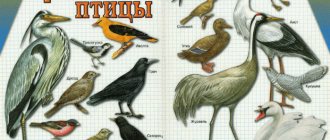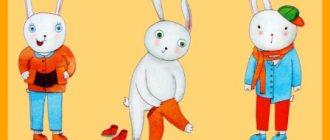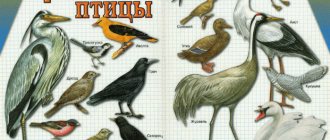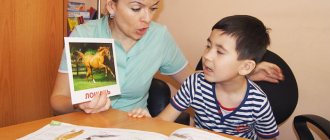LiveInternetLiveInternet
Quote from Tatyana57
Read in full In your quotation book or community!
SPEECH DEVELOPMENT. LEXICAL TOPIC “MIGRATION BIRDS”.
CHILDREN SHOULD KNOW THE NOUNS: rook, starling, swallow, swift, cuckoo, crane, geese, swans, lark, thrush, nest, birdhouse, male, female, chicks, eggs, singer, insects, larvae, plumage, flock, countries, legs , neck, wing, eyes, tail, beak, head, stork, heron. VERBS: fly, fly away, arrive, return, build, clean, set aside, curl, hatch, hatch, feed, grow up, get stronger, squeak, sing, curl, leave, say goodbye, gather, eat, peck, destroy, curl, nip, glue, blind. ADJECTIVES: big, small, singing, black, warm (edges), white, striped, caring, busy, spring, strangers, fluffy, ringing, field, distant, beautiful, long-legged, waterfowl, agile, vociferous. LET'S TELL ABOUT BIRDS. Migratory birds are birds that fly from us in the fall to warmer regions. These birds are insectivores (eat insects) and feed on insects.
In the fall, insects hide, the birds have nothing to eat, so they fly away. Ducks, geese and swans fly away in a line - a string.
Swallows and starlings fly away in a flock.
Cranes fly away in a wedge - an angle.
And the cuckoos fly away one by one. In spring, migratory birds return to us. Birds have a head with a beak, a body with two wings, two legs with claws, a tail and plumage.
CHILDREN SHOULD BE ABLE TO IDENTIFY EXCESS AND EXPLAIN: WHY? Magpie, crow, tit, swallow (swallow is a migratory bird, the rest are wintering). Lark, sparrow, rook, starling. Crow, duck, dove, sparrow. Rook, tit, swallow, cuckoo. Magpie, sparrow, woodpecker, swift. Dove, swan, heron, crane. Beetle, butterfly, chick, mosquito (chick is a bird, other insects). CORRECTLY NAME CHICKENS: Cranes are crane babies. Rooks - rooks. Geese are goslings. Starlings are starlings. Ducks -…. Cuckoos - ... . Swifts - ... . CORRECTLY ANSWER THE QUESTIONS: WHOSE? WHOSE? WHOSE? WHOSE? Whose beak? The crane has a crane-like appearance. The goose has goose. The duck has…. The cuckoo has…. The rook has…. ONE IS MANY. Cuckoo - cuckoos. Crane - cranes. Starling - starlings. Nightingale - nightingales. Lark - larks. Swan - swans. Rook - rooks. Duck - ducks. Swallow - swallows. Rook - rooks. Stork - storks. Gosling - goslings. WHO VOICES: The cuckoo cuckoos. The swallow is chirping. The starling sings. The crane is cooing. The duck quacks. The goose cackles. DESCRIBE AND COMPARE BIRDS ACCORDING TO PLAN: Wintering or migratory bird? Why are they called that? Appearance (tail, head, wings, body, beak, feathers, colors...) What does it eat? Where it lives - a hollow, a birdhouse, a nest... COMPILATION OF A DESCRIPTIVE STORY. The rook is a black bird with a white beak. The rook has a head, body, wings, tail, and paws. The bird's entire body is covered with feathers. In the spring, rooks fly from warm countries, build nests and hatch chicks - rooks. Rooks feed on insects, worms and plant seeds. In the fall, when it gets cold, rooks gather in flocks and fly away to warm countries until spring. Rooks help humans; they destroy insects and caterpillars - pests of fields and vegetable gardens.
The grass is turning green, the sun is shining, the Swallow is flying towards us in the canopy in the spring. With her, the sun is more beautiful and spring is sweeter... Say hello to us from the road as soon as possible. I’ll give you grains, and you sing a song that you brought with you from distant lands. (A. Pleshcheev) GIVE A WORD. There is a palace on the pole, in the palace there is a singer, and his name is ... (starling). CALL IT TENDINGLY: Nightingale - nightingale. Crane - crane. Swan - swan... WHO has WHO? The cuckoo has a cuckoo, cuckoo. The crane has a baby crane, crane babies. The starling has a little birdling, starlings. The swan has a baby, swans. The rook has a rook, rooks. The duck has a duckling, ducklings. The stork has a baby stork, baby storks. The goose has a gosling, goslings. END THE SENTENCE WITH THE WORDS “LONG-LEGGED CRANE”: In the field I saw ... (long-legged crane). I watched for a long time... (long-legged crane). I really liked this beautiful and slender... (long-legged crane). I wanted to approach... (long-legged crane). But he got scared and flew away. He flew beautifully, spreading his wings and circling in the sky... (long-legged crane). I told my mother about... (long-legged crane). Mom said that you shouldn’t come up and scare... (the long-legged crane). I promised my mother not to approach... (the long-legged crane) anymore. Now I will only watch from afar... (long-legged crane). CHOOSE THE PREPOSITION RIGHT BY MEANING (FROM, IN, TO, OVER, ON, ON): The rook flew out... nest. The rook has arrived... nest. The rook flew up... to the nest. The rook is circling... with his nest. The rook sat down... on a branch. The rook walks ... arable land. WE IMPROVE THE ABILITY TO RELL. RETELL THE STORY ACCORDING TO THE QUESTIONS: The rooks have arrived. The rooks arrive first. There is still snow all around, but they are already here. The rooks will rest and begin to build nests. Rooks build nests on the top of a tall tree. Rooks hatch their chicks earlier than other birds. Which birds arrive first in spring? What do the rooks immediately begin to do? Where do they build their nests? When do they hatch their chicks? Harbingers of spring. The cold winter has passed. Spring is coming. The sun is rising higher. It heats up more. The rooks have arrived. The children saw them and shouted: “The rooks have arrived! The Rooks Have Arrived!" What was the winter like? What comes after winter? How does the sun warm in spring? Who has arrived? Who did the children see? What did they shout? RETELL THE STORY IN THE FIRST PERSON: Sasha decided to make a birdhouse. He took boards, a saw, and sawed the planks. From them he put together a birdhouse. The birdhouse was hung on a tree. May the starlings have a good home. COMPLETE THE SENTENCE: There is a nest on the tree, and on the trees... (nests). There are branches on the branch, and on the branches... . There is a chick in the nest, and in the nests - .... There is a tree in the yard, and in the forest - .... GUESS THE RIDDLES: Without hands, without an axe. A hut has been built. (Nest.) Appeared in a yellow fur coat, Goodbye, two shells. (Chick.) There is a palace on a pole, There is a singer in the yard, And his name is... (Starling.) White-billed, black-eyed, He walks importantly behind the plow, Finds worms and beetles. A faithful watchman, a friend of the fields. The first harbinger of warm days. (Rook.) READ THE POEMS ABOUT BIRDS, LEARN ONE OF THEM BY MONEY. Starlings. We even got up at night and looked out of the window into the garden: Well, when, well, when will our guests arrive? And today we looked - a starling was sitting on an alder tree. They arrived, they arrived, they finally arrived!
Progress of the lesson
Introductory conversation with elements of theatrical performance
The teacher asks the children to take their seats, drawing their attention to the fact that an unusual envelope has appeared in the group from somewhere (which should be attached in advance in a visible place). The teacher reads the letter aloud. It says:
"Dear Guys! Autumn is writing to you. Help me please! Very soon my time will end, my sister Winter will replace me. I need to check the forests, fields, birds, animals. Did they all have time to prepare for the arrival of frosts, snowstorms, and cold? I can’t do everything alone, I need help! If you agree to become one, then I will send my faithful friend to you, he will explain everything.”
The children agree to help Autumn, and cheerful music begins to sound in the group. A Woodpecker bibabo doll appears on the screen, the toy says:
“Hello, girls and boys! I am so glad to meet you! Do you recognize me?
The teacher reads a trick riddle:
All day long in the forest I knock on all the trees. Doctor of the forest, but not a doctor. Did you guess it? I am…. (Children should not answer “rook”, but name another bird - woodpecker)
There are several more similar verses on the topic that could be used.
The doll continues the monologue: “Oh, how attentive and smart you are! We immediately guessed that this riddle was not about my friend the rook! Do you think it’s possible to see a rook in the forest now?”
The children answer, the teacher asks everyone to explain the answer.
Woodpecker: “That’s right, the rook has already flown to warm countries. We also need to remember other migratory birds that visit us only in the summer. This is what autumn asked me to ask you. Who do you know?
Ball game “Flying to warmer climes...”
All the children sit in a circle, the teacher takes the ball and says: “I know that the rook flew to warmer climes, but who do you remember?” The game continues as long as new names are heard.
The author Zatulina includes similar games in most of the notes for comprehensive classes on speech development in the senior group of kindergarten.
Lesson notes G.Ya. Zatulina
Woodpecker: “Oh, the little helpers worked hard! All my forest neighbors were remembered. That's right, they've all already flown away, the cold won't scare anyone. I’ll fly and say hello to Autumn from you, and tell you that we remembered all the migratory birds, and now we won’t be able to see any of them.”
The doll hides behind the screen.
Phys minute
The teacher invites everyone to stand up, repeating the words and movements after her (sequentially):
- The autumn rain is knocking: drip-drip, drip-drip! (we knock our feet softly on the floor).
- The sun is sleeping behind a cloud: bye-bye, bye-bye! (put your hands under your cheeks, sway from side to side).
- We have reaped the entire harvest: oh-oh, oh-oh! (Raises an imaginary load from the ground, raise it above your head).
- And they began to walk less often: br-rrrr, br-rrrr! (We hug ourselves with both hands, trembling).
A story about lovely birds based on a pictogram
The teacher draws the children's attention to the pictures she holds in her hands. She says:
“Guys, let's play an interesting game with you! These pictures contain clever icons that will help us teach about migratory birds. Let's try together! "
She shows the first picture and asks him to say what is drawn on it. Gradually all the pictures are posted on the board. The teacher takes out a card with a picture of a woodpecker and asks her to remember the riddle about him that she read at the beginning of the lesson. Everyone remembers the decoy poem together.
The teacher suggests talking about the bird using reference pictures and diagrams. Children take turns talking about the woodpecker (appearance, where it lives, what it eats, how it differs from other birds). The teacher reminds that the woodpecker is a wintering bird and can be found all year round. She asks the children to take one picture of migratory birds and tell about each one according to the diagram. Those who want to tell us.
Game “Which one has arrived?”
All cards with migratory birds are turned face down. She rises alone, at random. Children recognize the bird and name it (nightingale, rook, swallow, etc.). The teacher invites everyone to come up with a word that can be said about this bird (fast, swift, migratory, bright, motley). From time to time, the teacher helps the game by asking the question “Which one (which) flew/arrived to us…. swallow, starling, other migratory birds).
Riddle "The Fourth Wheel"
The teacher names four birds, three migratory and one wintering. For example: swallow, woodpecker, starling, thrush. Children must call the one that does not fly away to warmer climes for the winter “superfluous.”
You can find a list of similar logical tasks in the notes of classes on speech development in the senior group, devoted to other topics about birds.
All cards with birds are collected in an envelope that contained a letter from Autumn. Children say goodbye to them until next spring. The teacher asks them to recall the names of all the birds they collected and explain why they were given such a name.
Poetic pause
The teacher reads I. Tokmakova’s poem “Windy” and discusses it with the children. He asks everyone what he would draw in the picture for these lines. Several autumn pictures are hung on the board:
- early (September);
- golden (October);
- late (November).
Children are asked to identify the time of year that the poetess is talking about and the one outside the window now. The teacher asks to name the differences. She then suggests placing the pictures on the board in the correct order, from first to subsequent.
Game “Name it kindly!”
The teacher puts toy vegetables and fruits in an opaque bag. Invites each child to get one toy. Then the teacher calls out the words “vegetable” or “fruit” in turn and asks only those who are holding exactly what she just named to lift the toy.
After this, each student, in turn, must find an affectionate name for the “gift of autumn” that is in his hands. For example, a tomato is a tomato, an eggplant is an eggplant. The teacher suggests that almost all vegetables are easy to call affectionately, but fruits are more difficult.
Now two baskets are placed in front of the children. Everyone puts their toy either with vegetables or fruits. Then the contents of each basket are laid out on the table, then everyone looks for mistakes. If they are, then the fruits are laid out differently, correctly.
Tasks
- Enriching children's vocabulary.
- Teaching pupils how to write descriptive stories using reference cards (pictograms).
- Expanding ideas about the world around us, its main seasonal changes, plants, and living inhabitants.
- Formation in each child of social activity, the ability to express their own opinion, explain their point of view.
- General development of cognitive processes.
This summary on speech development in the senior group allows you to conduct a lesson that may be the final one for a block of autumn topics.







